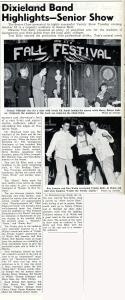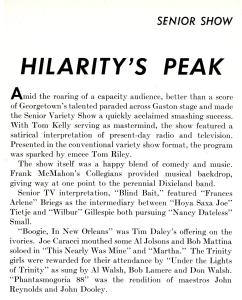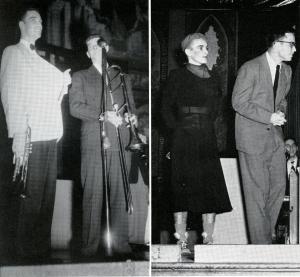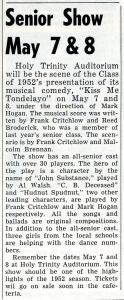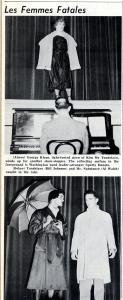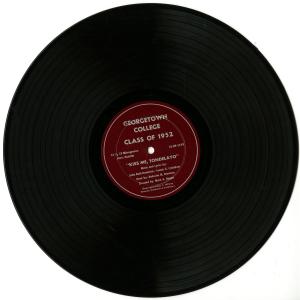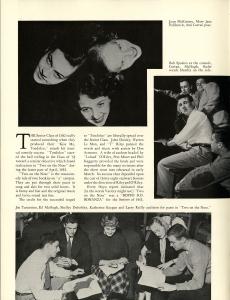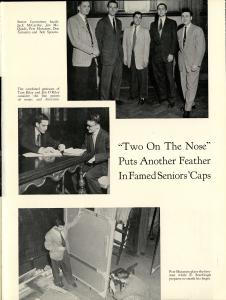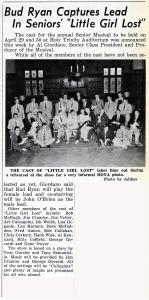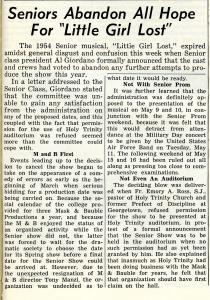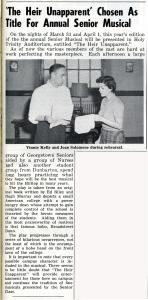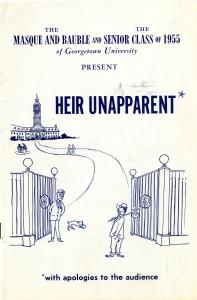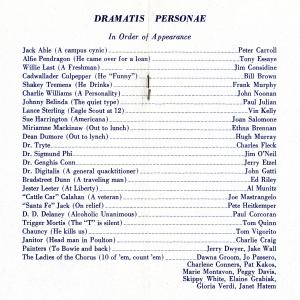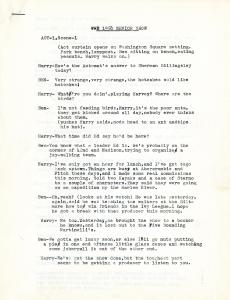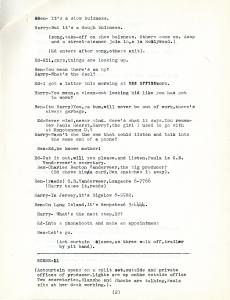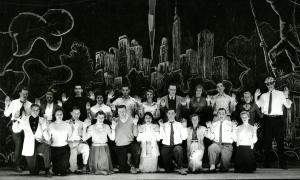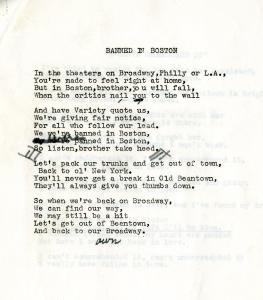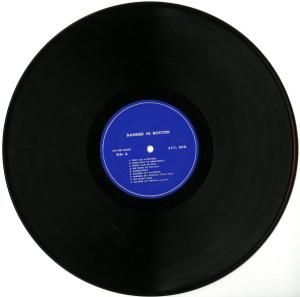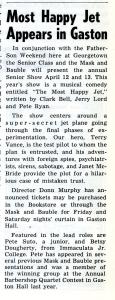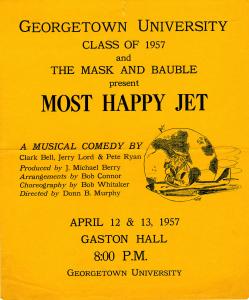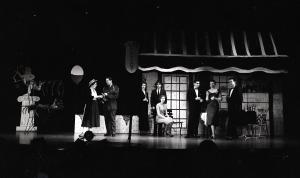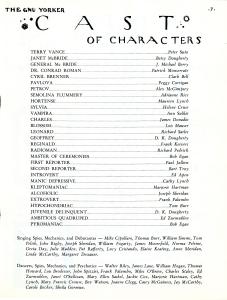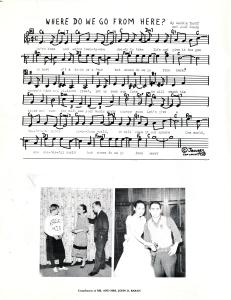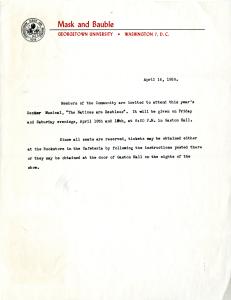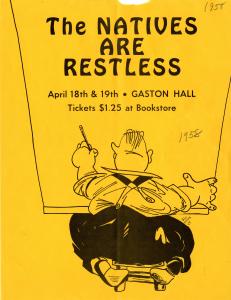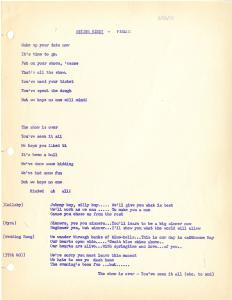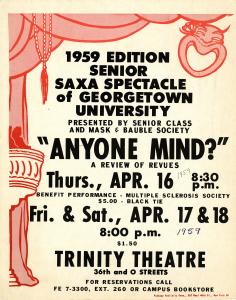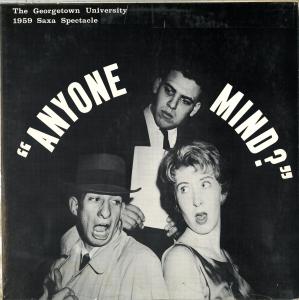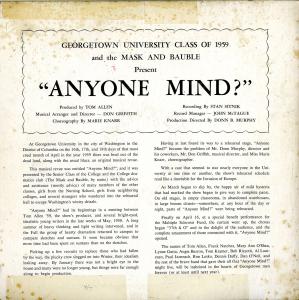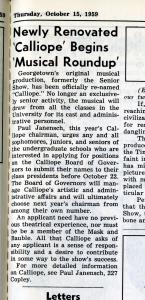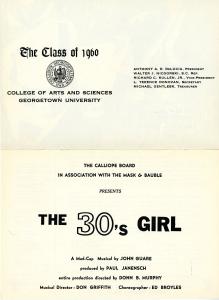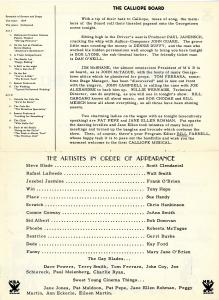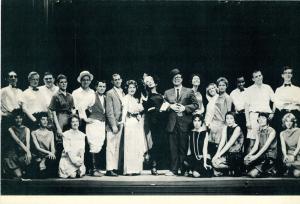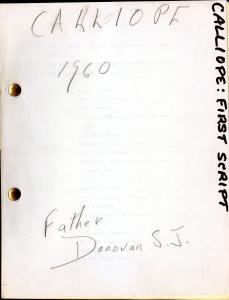From 1951-1959, the Senior Class at Georgetown organized, wrote and produced an original musical comedy show to the delight of fellow students, family and friends. What started with a simple variety show held in Gaston Hall in 1951, the Senior Show blossomed into a full-fledged musical stage production with a multi-night run and all the trimmings of the other Georgetown dramatic performances held throughout the year including printed programs, posters, production stills, and even some vinyl records. Proceeds from many of the shows went to support fundraising efforts for the annual Senior Class Gift.
After eight successful years (the 1954 show was cancelled), the Senior Show was reimagined in the fall of 1959 and rebranded as Calliope. The new production was open to students of all classes, rather than just seniors, and was led by a Board of Governors who oversaw the entire production. Calliope would go on to become its own tradition at Georgetown, running for 19 years before staging its final performance in 1978.
This exhibition showcases materials in the University Archives related to the Senior Show, including some newly digitized vinyl recordings, as well as some material from the first Calliope production: That 30s Girl.
Content warning: Please be aware that the exhibition contains documents that use outdated and potentially offensive terminology with regards to indigenous people.
“Dixieland Band Highlights--Senior Show”, The Hoya November 1, 1951
The first event to be dubbed the Senior Show took the form of a variety show, with students showcasing their musical, acting, and even magical talents. Seniors Tom Kelly and Tom Riley were responsible for coordinating and hosting the well-reviewed event.
“Senior Show May 7 & 8”, The Hoya, April 25, 1952
Unlike the previous year’s variety show format, the 1952 Senior Show was presented as a musical comedy play written by Frank Critchlow and Malcolm Brennan. The show was also moved from the fall to the spring; closer to the regular end-of-year senior activities.
The play, titled Kiss Me, Tondelayo, was the first to incorporate women in the production. While some information about the production is documented in The Hoya, and a few photographs from the production appear in Ye Domesday Book, a description of the plot of the play has proved elusive.
Vinyl Record for Kiss Me, Tondelayo, 1952
Music and Lyrics by John Reid Broderick and Francis X. Critchlow. To listen to an audio recording of this performance, click here.
Photographs and a Recap of Two on the Nose, Ye Domesday Booke, 1953
1953 saw another successful production of the Senior Show. Written by John Dooley, Warren Lemon, Jim O’Riley, and Tom Riley, Two on the Nose, follows the story of two roommates at “Eastern University” who find themselves in what The Hoya referred to as “...some unforgettably riotous circumstances…” and went on to declare that “...if the final product is merely half as funny as any one of the rehearsals, you'll need adhesive plaster to keep your sides from splitting.”
Two on the Nose was the first of the Senior Show productions to be produced in conjunction with Mask and Bauble, a partnership that would continue for the subsequent Senior Shows.
“Bud Ryan Captures Lead In Seniors’ ‘Little Girl Lost’”, The Hoya, March 18, 1954
Not much is known about the story for Little Girl Lost as the play itself was never performed. The Hoya mentions some details, though, such as that the play was based on a story by Tony Oursler and Tony Santaniello with music by Jim Cramise and George Gerardi.
“Seniors Abandon All Hope for ‘Little Girl Lost’”, The Hoya, April 29, 1954
Following scheduling issues and a failure to secure permission from the pastor at Holy Trinity Church to use the auditorium, the cast and production staff of the Senior Show elected to cancel the performance.
“ ‘The Heir Unapparent’ Chosen As Title For Annual Senior Musical”, The Hoya, March 24, 1955
Following the disappointment of the previous year, the 1955 Senior Show returned in triumphant fashion with Heir Unapparent, written by Ed Riley and Hugh Murray. The plot takes place at the fictional Dunville College where a power-hungry dean tries to take over the school. He is thwarted, of course, by the heroic students of the school who are aided by Bradstreet Dunn, known as “A Traveling Man” in the program and perhaps the Heir Unapparent in question.
Draft Script of Act 1, Scene 1 of Banned in Boston, 1956
The 1956 Senior Show was written by Tony Kobus, Don Lawler and Ted Zolkiewicz. The plot, according to The Hoya “...concerns the trials of the young writers who are trying for fame and fortune on Broadway, and their difficulties with a fantastic producer and his equally unbelievable leading lady.”
Banned in Boston was the first Senior Show to be directed by Donn Murphy, who had only just assumed duties as Director of Mask and Bauble in 1955. Murphy’s career at Georgetown would span over 40 years; he retired as Professor Emeritus in 1999. This show was also one of the premier events on the schedule for the inaugural Father-Son Weekend at Georgetown. Father-Son Weekend would later become Parent’s Weekend in 1961.
Vinyl Record for Banned in Boston With Lyrics from Select Musical Numbers, 1956
To listen to an audio recording of Banned in Boston, click here.
“‘Most Happy Jet’ Appears in Gaston”, The Hoya, April 11, 1957
Written by Clark Bell, Jerry Lord, and Pete Ryan, the plot revolves around a top-secret experimental jet, a young and eager test pilot, his beautiful love interest and various other zany characters who bring mystery and intrigue to the production. To listen to an audio recording of this performance, click here.
Program for The Natives are Restless, 1958
Making a return to its earlier roots, the Senior Show of 1958 staged a musical revue with various musical numbers and sketches. Writing duties for the music fell to Peter Ryan, Manny Murgola, John Byrne, and John Guare while the sketches were penned by a majority of the performers.
Letter from Mask and Bauble on Their Letterhead Inviting the Georgetown Community to Attend the 1958 Senior Show, April 16, 1958
Script of the Finale of Anyone Mind?
Dubbed the 1959 Saxa Spectacle, the Senior Show of 1959 also took the format of a musical revue. Writing credits are attributed to Dennis Duffy, Paul Janensch, Dan O’Neill and Walt Smith. Once again, Donn Murphy directed the show; his fourth Senior Show in a row.
Proceeds from one of the performances went to benefit the National Multiple Sclerosis Society and, because of this, the production enjoyed sponsorship from a plethora of notable people, including Mamie Eisenhower.
“Newly Renovated Calliope Begins ‘Musical Roundup’”, The Hoya, October 15, 1959
For reasons unknown, the Senior Show was reimagined following the 1959 production and rebranded as Calliope. Still an original musical comedy production organized and produced by students, Calliope allowed for all Georgetown students to participate regardless of their class year. Calliope ran for 19 years ending its run in 1978 with the production Wiley!
Curated by Ann Galloway, Assistant University Archivist

